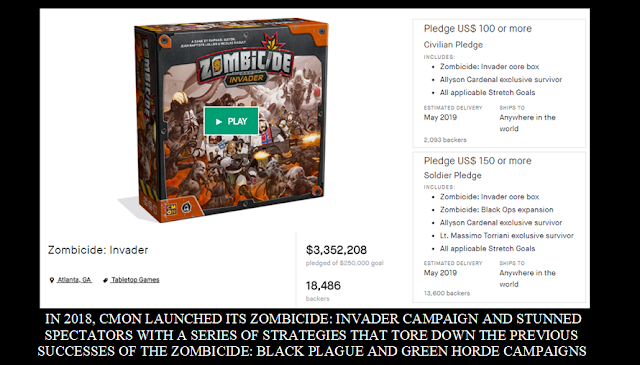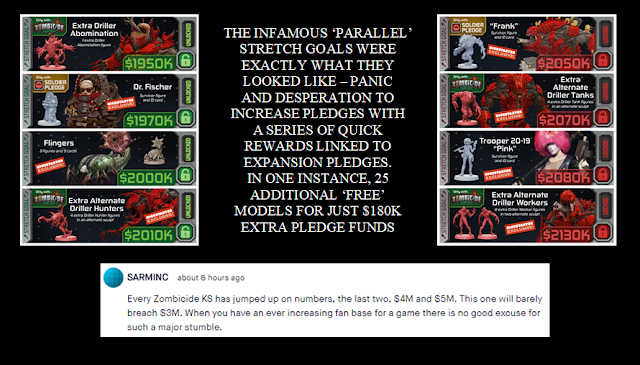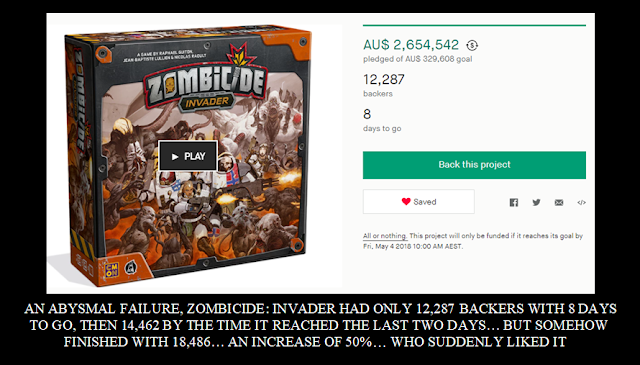ZOMBICIDE: INVADER EPIC FAIL – PART 2
BLACK PLAGUE, GREEN HORDE
GW was probably livid about this activity. They had demonstrated increasing acts of hostility toward any competition over the years, and even ignored anti-competition laws as they attempted to interfere with rivals and client-retailers in countries where they traded. Their aggression toward their competition, the client-retailers, and customers, raised many eyebrows and resulted in serious losses in both their market base and profits. GW compensated by simply raising their already insane prices. The customers that remained, mindlessly loyal, continued to shovel money at GW, happy to be violated in return.
GW also claimed the last half year pre-tax results for 2016 had more than doubled from the same period in 2015, but their ‘revenue’ is somewhat misleading. They re-released a popular game (Space Hulk) and made a lot of quick cash, just like they did with almost every other game… before dumping it again. This was no surprise to former player-customers, but left the newer player-customers reeling. They had been abusive toward older players who tried to warn them… only to suddenly find themselves in the same situation. Ripped off, cheated, used, and set upon by the next generation of mindless fanboy trolls.
It made a lot of quick profit from new and elitist-fanboy players, but generated a lot more ill-will with fallout that will inevitably play out over the next few years. Sure, GW made a lot of money, and claimed a revenue of around US$184.5M with a pre-tax profit for 2017 of US$49.5M, but it was little more than a pyramid scheme… where the market base is the point and the mass of everything else is balanced on top, precariously. CMON’s efforts to encroach on this were barely a blip on the radar as GW rolled on.
It all
really started for CMON with Zombicide.
Not the original game, but the next one, Black
Plague. The December 2015 Kickstarter. It raked in just over US$4M with
almost 21,000 backers. A base pledge of US$100 provided a Core Box with 71
miniatures and a Hero Box that added another 5. The Wulfsburg expansion added a further US$50 to the pledge but
provided 26 more models… plus an exclusive model. It is unclear what benefit
was gained for the US$10 second ‘expansion’.
Day 1 of the Kickstarter Campaign for Black Plague was astonishing. It had a funding target of US$125K but reached US$710K in just the first three hours! At the conclusion of the first day it managed to secure US$1,080K. Over eight-and-a-half times the original funding target. However, in order to reach this total, CMON had given away 43 additional miniatures as Stretch Goals (SG). These were free content provided to backers as an incentive to pledge funds to the project.
Day 1 of the Kickstarter Campaign for Black Plague was astonishing. It had a funding target of US$125K but reached US$710K in just the first three hours! At the conclusion of the first day it managed to secure US$1,080K. Over eight-and-a-half times the original funding target. However, in order to reach this total, CMON had given away 43 additional miniatures as Stretch Goals (SG). These were free content provided to backers as an incentive to pledge funds to the project.
People who
purchased Black Plague at retail
would not get the SGs unless they were available at retail, and they would have
to purchase them. If a SG was listed as ‘exclusive’, it wasn’t available at
retail at all. By the third day, the campaign reached US$1,500K, but then it
slowed. It was day eleven before it got to US2M. In what became a standard,
pre-planned strategy, Updates 38 and 45 each also saw a special guest box
character changed to a Necromancer. The exact update for this shifted each
campaign, but at least one Survivor was changed in this manner (allegedly) in
‘response’ to feedback from the backers.
By the end
of the campaign, Black Plague had a total pledge of US$4,078,954. CMON said in
the Update marking this, “And so we come to the end of all things. We honestly
did not expect this campaign to do as well as it did, and often had to scramble
to create new rewards based on your feedback (and thanks to the tireless work
of our contributing artists and sculptors). Now it's time to start the
celebration, as the last grains of sand trickle down the hourglass of our
campaign!”
So what
did the backers get? In addition to getting the products cheaper than retail, they
would also receive additional content (mostly more miniatures) in the form of SG
unlocked when specific funding targets were reached to incentivise people to
pledge more money. There were 88 of these. About 40% of them were exclusive
only to the backers, 9 contingent upon pledging for an expansion, and over a
dozen were simply represented with drawings rather than 3D rendered sculpts. It
worked out at about US$0.77 a model if you treated the rest of the content as being
free.
Meanwhile,
retail backers had to pay US$100 for Black
Plague, US$25 for the Hero Box, and US$60 for Wulfsburg. They didn’t get any of the SGs and did not even have the
option to purchase exclusive items. They had to pay US$35 more for less. People
who funded the Core Box during the kickstarter got 88 (almost +116%) more
models than people who purchased it at retail! Needless to say, while the game
did reasonably well at retail, those who learned about the benefits kickstarter
backers got afterwards felt extremely cheated. They were paying for the backers
to be given more for less.
There’s
no point mentioning the rules, cards and other things in the box because the
game mechanics themselves were simplistic, unrealistic, restrictive, and dull
to the point of “why bother?” Most backers were there for the miniatures. Many
of them intended to use these for other games. CMON knew this. They were making
a move to claim market share from GW. They saw a market being treated badly,
ripped-off, angry, and looking for something better (or at least more
affordable). CMON saw this as an opportunity and seized it. They provided
something absent from the market: competition.
GW was probably livid about this activity. They had demonstrated increasing acts of hostility toward any competition over the years, and even ignored anti-competition laws as they attempted to interfere with rivals and client-retailers in countries where they traded. Their aggression toward their competition, the client-retailers, and customers, raised many eyebrows and resulted in serious losses in both their market base and profits. GW compensated by simply raising their already insane prices. The customers that remained, mindlessly loyal, continued to shovel money at GW, happy to be violated in return.
Still,
any media articles on the issue were hard to find outside small social media
forums. GW was never really a company of any note, only for the train-wreck
spectacle they created, especially in its decline, and CMON was a tiny up and
comer of no real interest (apparently) in the grander scheme of things. Black Plague managed to gather 21,000
backers and US$4M, but on a global scale this wasn’t even noteworthy. In 2015
GW was struggling to overcome the shit mess it had created over the previous
two decades, but still made profits of US$25.5M before tax that year, and
US$24.3M before tax in 2016.
GW also claimed the last half year pre-tax results for 2016 had more than doubled from the same period in 2015, but their ‘revenue’ is somewhat misleading. They re-released a popular game (Space Hulk) and made a lot of quick cash, just like they did with almost every other game… before dumping it again. This was no surprise to former player-customers, but left the newer player-customers reeling. They had been abusive toward older players who tried to warn them… only to suddenly find themselves in the same situation. Ripped off, cheated, used, and set upon by the next generation of mindless fanboy trolls.
Perhaps the most ‘amusing’ part of the ‘new’
Games Workshop attitude and approach to its market was that it was ‘new’ at
all. They appeared to recognise that they had screwed over their customers and
had a desperate need to expand their market base, but the bizarre belief that
their former victims would be willing to line-up and bend over again was
astonishing. Still, they had learned the smaller, less expensive games they
sold were more popular because they were affordable… but, of course, then they withheld
content that they would sell as expansions, continuing the cycle of add-ons to
rake in more cash.
Aside from re-releasing popular games for quick
short-term profits, GW continued to jack up prices. It was the same tired-old
tactic… but it worked. It did little to increase their market base, if at all. Even
reduced, those left covered loses as GW made more for less. GW also sold
‘their’ IP licence to computer game developers. It was a lot of very clever
fact fudging to create the illusion of prosperity. But still, despite being a
space hulk (see what I did there?), GW’s profits dwarfed (because they have
their own over-priced advertising magazine called White Dwarf… nice!) those of Black Plague.
In 2018, CMON launched their Zombicide: Green Horde kickstarter, hoping to cash in on the popularity of Zombicide: Black Plague… and the increasing unpopularity of GW in the wake of their decades old foundational game Warhammer Fantasy Battles being dropped. Admittedly, that game ceased to exist years earlier, moving through third-to-eighth editions in twice as many years before being rereleased under the new name Age of Sigmar. GW, at the time, touted it as a revolutionary move forward…
In 2018, CMON launched their Zombicide: Green Horde kickstarter, hoping to cash in on the popularity of Zombicide: Black Plague… and the increasing unpopularity of GW in the wake of their decades old foundational game Warhammer Fantasy Battles being dropped. Admittedly, that game ceased to exist years earlier, moving through third-to-eighth editions in twice as many years before being rereleased under the new name Age of Sigmar. GW, at the time, touted it as a revolutionary move forward…
It made a lot of quick profit from new and elitist-fanboy players, but generated a lot more ill-will with fallout that will inevitably play out over the next few years. Sure, GW made a lot of money, and claimed a revenue of around US$184.5M with a pre-tax profit for 2017 of US$49.5M, but it was little more than a pyramid scheme… where the market base is the point and the mass of everything else is balanced on top, precariously. CMON’s efforts to encroach on this were barely a blip on the radar as GW rolled on.
The strategy for Green Horde was similar to the one CMON used for Black Plague, but with a few small
modifications to rake in more revenue. This time they managed to get over
24,000 Backers and US$5M in funding. It may have looked good to get that 25%
increase in funds, but it was generated by only an additional 14% of Backers.
How was this possible? Look at the pledge options. This time the Core Box was
US$120, with a pair of expansions that each added a further US$50 to the pledge
total.
What did backers get this time? Well, for the
pledge of US$120 they got 72 miniatures plus 61 (+85%) more in the form of
special bonuses and SGs. Most of these were exclusive models. The Friends and Foes and No Rest for the Wicked expansions added
another 29 and 35 more, plus each came with an exclusive. Some of these 199
miniatures were giants, dragons and siege weapons. That worked out at about
US$1.11 per miniature, about 44% more expensive than Black Plague. Again, there’s really no point mentioning the cards,
rules and other content because it’s all about the miniatures.
But this time, the Core Box and two expansions
cost backers US$220 rather than the US$150 the Black Plague kickstarter had required. Change that to the local
currency of where it was being sent, then add around 30% for postage, and it suddenly
becomes very expensive (eg, AU$370). More so if backers increased the pledge to
cover Optional buys, many of which were (again) exclusive to the kickstarter
backers. When it suddenly costs half a week’s minimum wages, it gets hard to
fund.
At the time, people like me suggested maybe CMON
try a different approach. Maybe just sell the Core Box during a kickstarter,
and do another kickstarter every 4-6 months for each expansion, so backers can
fund it. If the product is more affordable, they can budget for it, but all at
once it reduces the number of people who can afford to back it. The trolls, of
course, quickly unleashed upon anybody who didn’t post pure positive,
sycophantic drivel, and bullied into silence anyone making such suggestions.
Again, at
the time, people like me suggested CMON do something to discourage the trolls,
pointing out that insulting potential buyers rarely resulted in a positive
outcome or increase in sales. CMON did very little. The trolls were enabled as
a result. In any case, CMON was disinterested in any real feedback from its
market. If you didn’t just buy their product and put up with their trolls, you
didn’t matter. Once again, the products didn’t do as well at retail. Word had
begun to spread, and most retail customers didn’t like getting less content
while paying the same or more for (part of) the products.

















Comments
Post a Comment